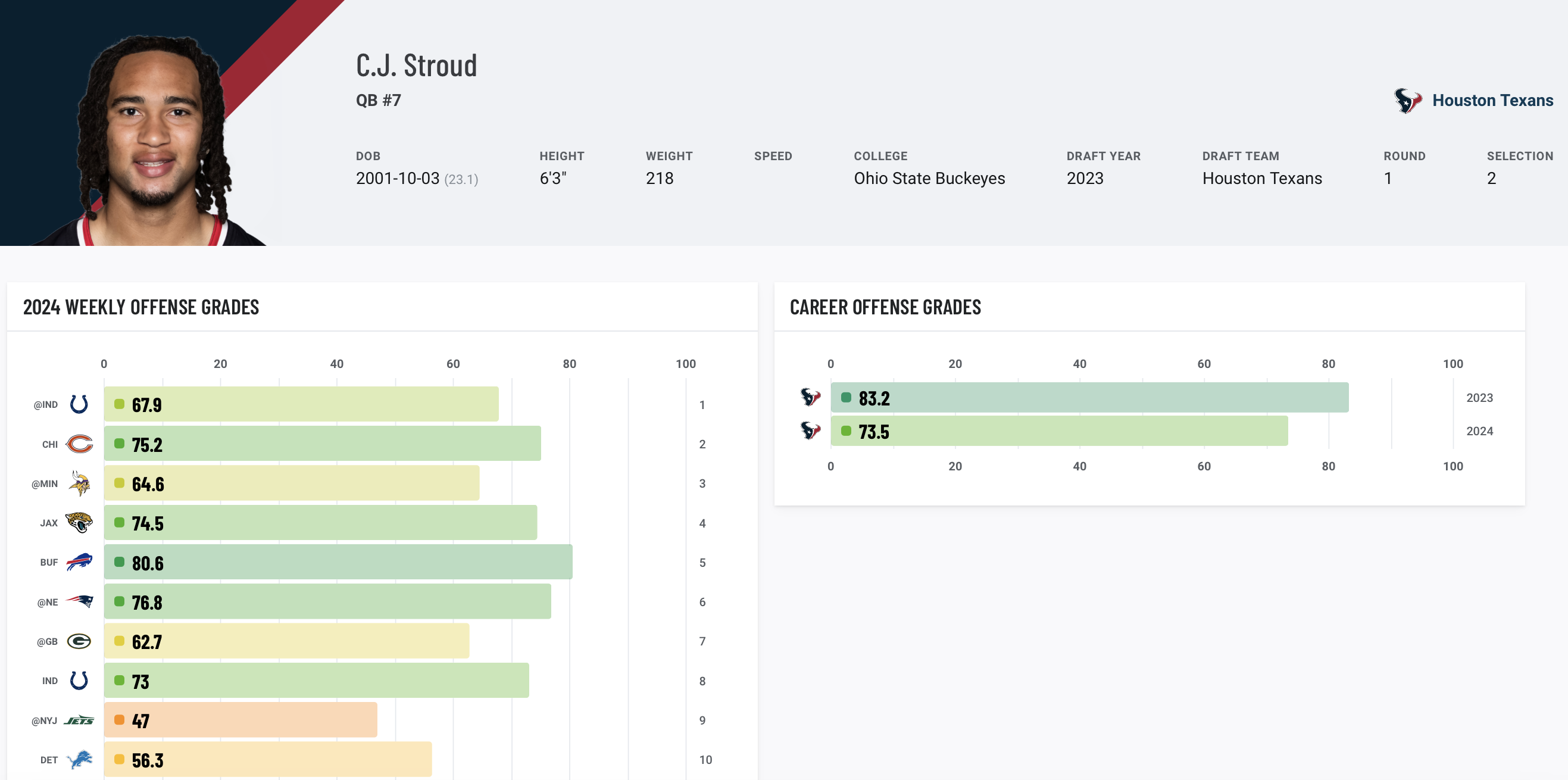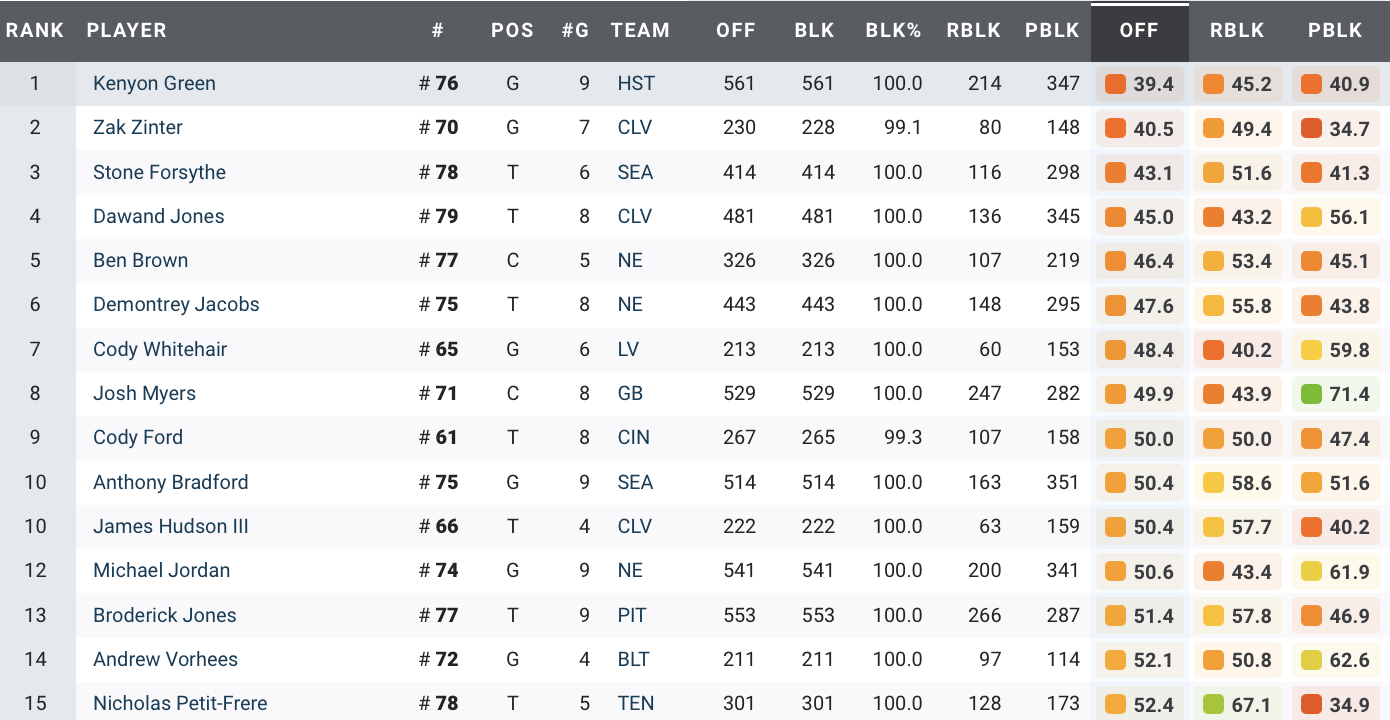• A run game that still can't get going: The Texans are in the bottom five in rushing EPA per play and rushing yards before contact.
• The return of Nico Collins could help C.J. Stroud: Stroud's deep passing has diminished this year, but getting back the league's top receiver by grade may be the necessary fix.
• Unlock your edge with a PFF+ subscription: Get full access to all our in-season fantasy tools, including weekly rankings, WR/CB matchup charts, weekly projections, the Start-Sit Optimizer and more. Sign up now!
Estimated reading time: 6 minutes
Entering the 2024 NFL season, the Houston Texans figured to have assembled one of the best offenses in the league. C.J. Stroud returned for his sophomore season after winning Offensive Rookie of the Year, already cementing himself as one of the best quarterbacks in football. The Texans added Stefon Diggs to a receiver room that returned Nico Collins and Tank Dell. Oh, and the team swooped up Joe Mixon. And with offensive coordinator Bobby Slowik staying in Houston despite receiving head coaching buzz, this unit felt like it was brimming with potential.
Fast forward 11 weeks and the results wouldn't be reminiscent of rapper Travis Scott’s Utopia. The Texans rank only 19th in EPA per play on offense, not to mention 25th in yards per play and 28th in successful play rate. Why have things gone so horribly awry?
Yes, injuries have taken their toll. Collins played Weeks 1-5 but subsequently went on Injured Reserve, missing the next five games. Diggs tore his ACL in Week 8 after posting a 79.7 receiving grade. However, Houston has struggled independently of those problems. The Texans ranked 18th in EPA per play with Collins in Weeks 1-5, so it’s not just losing talent.
A Bad Rushing Offense
The biggest affront facing Slowik’s offense is a continued inability to run the ball. Houston sits 30th in rushing EPA per run play, which is somehow worse than the 23rd ranking the team attained last season. Along those lines, the Texans have been 27th in average rushing yards before contact in both of the last two years.
Most of the blame can be doled out to Houston’s offensive line. Only one starter — star Laremy Tunsil — has recorded a run-blocking grade above 65.0. Altogether, the Texans rank 23rd in team run-blocking grade.
Even though Houston has been stymied trying to run all season, that hasn’t stopped Slowik from trying to establish it. In fact, the Texans entered Week 10, having run the 10th-most rushing plays all year, up from 16th a season ago.
Poor Situational Play
In addition to a very underwhelming run game, the Texans have inhibited their offensive efficiency by being bad in several distinct categories.
The first is on early downs, where Houston hasn’t produced well enough to set up easier late-down conversion tries. The Texans rank 28th in EPA per play on first and second down; for context, that ranking was 12th a season ago. In particular, Stroud has struggled tremendously on first and second downs, sitting in the 41st percentile of passers in terms of early-down passing grade compared to the 73rd last season.
Likewise, the Texans haven’t fared well in the second halves of games. On the season, Houston ranks 25th in EPA per play, not to mention 30th in success rate, in the third and fourth quarters. Meanwhile, the team ranks 19th in EPA per play in the first half. Stroud’s play has followed suit: the former No. 2 overall pick is the league’s sixth-best passer in the first half but is positioned 23rd out of 27 qualifying QBs in the second half.
Interestingly enough, Slowik has tweaked his offense by adding more motion this season, upping the team’s shift/motion rate from 14th to seventh. Yet, Houston isn’t producing the desired results while trying to confuse defenses. The Texans rank only 20th in EPA per play when using motion. In simpler terms, more motion isn’t translating to better results.

Slightly Worse Play from Stroud
Following a remarkable rookie season, some of Stroud’s advanced numbers actually look better this year. His big-time throw rate has increased by 0.4%, and his turnover-worthy play rate has diminished by 0.4%. On top of that, Stroud is generally charted as being more accurate in almost every category, plus better under pressure. So, what gives?
The most glaring difference is Stroud’s play in a clean pocket, where his percentile ranking has plummeted from the 90th to the 26th percentile. Part of that fall-off may be due to his big-time throw rate in clean pockets dipping from 4.3% last year to 3.0% this season. Moreover, Stroud has been worse at avoiding negative plays, sliding from the 52nd percentile to the 23rd in that category this year.
The biggest indictment of Stroud’s play in 2024 has been as a much worse deep passer. After grading as the league’s best deep thrower last year with a 99.3 passing grade, that figure has dropped all the way to 76.5. Along those lines, Stroud’s inferior year-over-year completion percentages on passes of 20-plus yards (58.5% to 32.4%) and turnover-worthy play rates (1.4% to 7.9%) reflect a player who simply has not been nearly as good at throwing down the field.
Another area in which Stroud has actually cleaned up is avoiding pressures himself, with his personal allowed pressure rate declining by 3.2%. The problem, though, is that he’s simultaneously been worse at not being sacked. Stroud’s pressure-to-sack ratio has elevated from 17.4% to 22.4%.
A Subpar Interior Offensive Line
Houston’s offensive line appeared to be in relatively solid shape this year, retaining the stellar Tunsil at left tackle while returning former first-round pick Kenyon Green at left guard. However, the results have been the exact opposite.
The Texans have gone from 18th to 27th in total pressure rate allowed, which obviously obviates Stroud for some blame for his worse play. The team’s guards and center have been the primary culprits, ranking 27th in pass-blocking grade and 31st in pressure rate — compare that to a pressure rate that sat 16th last year.
The fundamental headache has been Green. After being sidelined for all of last year, the 23-year-old has been a legitimate liability. His 39.4 overall grade is the worst among all offensive linemen who have played 200 or more snaps, with his pass- and run-blocking marks both below 46.0.

Potential Remedies
The Texans have hit a bit of a slump, dropping their last two games. But Houston is still 6-4 and has a 90% chance of winning the AFC South. The playoffs are all but a lock — but how can this team build off last year’s playoff run and compete for a title?
The return of Collins can’t be overstated. His 92.4 receiving grade is still the best in the league, while his 3.50 yards per route run is somehow better than his absurd 3.11 mark last season.
Stroud should play much more comfortably with No. 12 back on the field, which only boosts the entire unit. Plus, given an extremely favorable matchup against a DaRon Bland-less secondary, expect big results from Collins in his first game back.
Houston could also receive better play from Dalton Schultz. The veteran tight end has seen his receiving grade drop from 72.6 to 60.9. Even though Schultz has yet to drop a pass, his separation percentage percentile has dwindled from 74th to 39th. But Schultz seemed to return to form against the Lions, catching three passes for a season-high 66 yards and an 82.4 receiving grade. That’s a step in the right direction.
The big focus for Houston on Monday night will be slowing down Micah Parsons, who racked up five pressures, two sacks and a gaudy 90.5 pass-rushing grade in his Week 10 return. If Tunsil and Tytus Howard can neutralize Parsons on the outside — where Parsons has lined up on 87.8% of snaps this year — then that should mean better results for Houston's IOL. For context, the Cowboys' highest-graded interior defender is Osa Odighizuwa, at just a 62.2 overall grade.
In terms of schematic fixes, trying to turn toward a more pass-heavy approach likely makes sense, given that the Texans are unlikely to rapidly improve their run-blocking in only seven weeks. A focus on playing with more urgency in the second half is also paramount — that’s precisely why Houston squandered a five-interception game from Jared Goff in Week 10.



 © 2024 PFF - all rights reserved.
© 2024 PFF - all rights reserved.